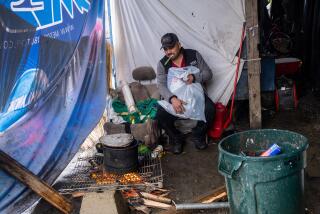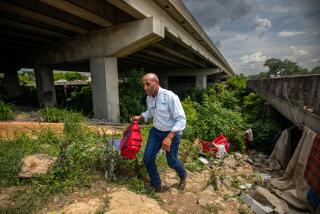How we measure poverty
- Share via
Who is poor in America? It turns out that’s a hard question to answer.
The federal government’s badly outdated method of measuring poverty provides an inaccurate picture. New York found the official numbers so useless that the city recently developed its own poverty measure. Other cities, including Los Angeles, are considering doing the same thing, and those efforts are expected to be high on the agenda when the U.S. Conference of Mayors meets in Los Angeles on Sept. 23-24.
But what’s most needed is an overhaul of the nation’s poverty measurement statistics. The good news is that legislation is being drafted in both the House and Senate. A change is long overdue.
Why does it matter if we have a good measure of poverty? In the last four decades, the U.S. has greatly expanded programs for lower-income families, including food stamps, housing vouchers, medical care assistance and tax credits. But the poverty rate doesn’t take any of these resources into account because it doesn’t account for taxes or noncash income. At the same time, Americans’ medical expenses have increased, and more single parents work and pay child-care expenses. The current poverty measure is unaffected by these changes too.
The result? Poverty statistics that make it depressingly easy to claim that public spending on the poor has had little effect. Indeed, most programs to help the needy would never budge the U.S. poverty rate the way we measure it now.
The current measure of poverty was established in 1964 by a Social Security Administration economist named Mollie Orshansky. Looking at data from 1955 -- the best available in the early 1960s -- she found that a family spent, on average, one-third of its income on food. Hence, three-times-food became the official poverty line. That line has ticked upward only by being adjusted for inflation each year.
No other regularly reported economic statistic has been unchanged for four decades. Food prices have fallen; today, food constitutes less than one-seventh of the average family’s budget. But people pay substantially more for housing and energy.
Still, the old poverty measure continues to be used by all sorts of government programs. Some use it for eligibility limits; most families below 130% of the poverty line, for instance, are eligible for food stamps. Some federal block grants to states are partly based on state poverty levels.
In 1995, I participated in a panel of scholars at the National Academy of Sciences (NAS), a group that advises the federal government on scientific issues. We recommended a far more effective way to establish a poverty threshold, based on expenditures for a bundle of necessities, including food, shelter, clothing and utilities. Furthermore, this threshold would vary geographically, based on differences in housing costs.
This would mean that families in Los Angeles have a different poverty line from families in rural Wyoming. When New York calculated a new threshold with this methodology, officials found that it was $21,818 for a family of four, not far from the official U.S. figure of $20,444. But when they adjusted for New York’s high housing costs, it rose to $26,138.
But the poverty measure also needs to recognize that the resources in low-income families extend beyond wages and cash income. The NAS panel recommended a much broader definition, including cash income adjusted for tax payments, plus the value of government benefits such as food stamps or Section 8 rental vouchers. Unavoidable costs were subtracted from income, as well, because working requires spending money on transportation and, often, child care. Similarly, out-of-pocket medical expenses also were deducted.
Why weren’t these changes made years ago? That’s a story of politics getting in the way of good statistics. Back in the 1960s, the poverty measure was placed under the control of the White House. This is in contrast to all of our other national statistics, which are defined and updated by agencies with a long history of nonpolitical decision making.
Unfortunately, no president (Democrat or Republican) has wanted to touch this political hot potato. If a new measure shows higher poverty, the president looks bad, but if a new measure shows lower poverty, he’ll be accused of dismissing the problem.
And the numbers will change. In New York, where the official U.S. poverty measure finds 18% of the city is poor, the new measure (largely because of housing costs) finds 23%. But the picture will be more accurate. New York found rates differed little for children but were much higher for the elderly because of out-of-pocket medical expenditures.
That’s why Congress needs to pass legislation to direct one of the statistical agencies to calculate a new federal poverty measure, guided by the NAS recommendations. Under a new measure, single-mother families receiving food stamps and in subsidized housing would appear a little better off; disabled individuals with high medical expenses, a little worse. Families in big cities with high housing costs, such as in California, would be poorer, and families that receive working tax credits less poor.
But that is just as it should be. If we want to debate new policies to help the poor, we first need a poverty measure that shows us who they really are.
Rebecca M. Blank is the Robert V. Kerr senior fellow in economics at the Brookings Institution in Washington.
More to Read
Get the L.A. Times Politics newsletter
Deeply reported insights into legislation, politics and policy from Sacramento, Washington and beyond. In your inbox twice per week.
You may occasionally receive promotional content from the Los Angeles Times.










